Physical Modeling of Positive Multistrike Lightning Formation
Abstract
:1. Introduction
- The formation mechanisms of continuous currents and M-components;
- The mechanisms of the “connection” of neighboring regions with an increased density of negative charge (lightning cells) to the place of the first main discharge in a thundercloud;
2. Experimental Measurement Complex
3. Physical Modeling of Positive Multistrike Lightning Formation Processes Using Artificial Thundercloud Cells
- Due to the influence of the electric field of the upper ATC, there is a deeper penetration of the discharge system developing from the upper model hydrometeors in the group inside the lower ATC.
- The probability of the formation of repeated discharges has increased (up to 27% of all experimental approaches).
4. Analysis of Results and Discussion
5. Conclusions
- −
- When the second group of model hydrometeors was introduced into a single cell, the probability of initiating repeated discharges increased by almost three times.
- −
- The presence of the second artificial thundercloud cell increased the probability of the initiation of repeated discharges by a single group of model hydrometeors by almost four times.
Author Contributions
Funding
Institutional Review Board Statement
Informed Consent Statement
Data Availability Statement
Conflicts of Interest
References
- Cooray, V. The Lightning Flash; IET Publishing: London, UK, 2014. [Google Scholar]
- Dwyer, J.R.; Uman, V.A. The physics of lightning. Phys. Rep. 2014, 534, 147–241. [Google Scholar] [CrossRef]
- Mazur, V.A. Principles of Lightning Physics; IoP Publishing: Bristol, UK; New York, NY, USA, 2016. [Google Scholar]
- Betz, H.D.; Schumann, U.; Laroche, P. (Eds.) Lightning: Principles, Instruments and Applications. Review of Modern Lightning Research; Springer: Berlin/Heidelberg, Germany, 2009. [Google Scholar]
- Mazur, V.; Ruhnke, L.H.; Warner, T.A.; Orville, R.E. Recoil leader formation and development. J. Electrost. 2013, 71, 763–768. [Google Scholar] [CrossRef] [Green Version]
- Cooray, V. An Introduction to Lightning; Springer: Dordrecht, The Netherlands; Uppsala, Sweden, 2015; 386p. [Google Scholar]
- Saba, M.M.; Campos, L.Z.; Warner, T.A. High-speed video observations of the dissimilarities between positive and negative cloud-to-ground flashes. In Proceedings of the X International Symposium on Lightning Protection, Curitiba, Brazil, 9–13 November 2009; pp. 179–183. [Google Scholar]
- Rakov, V.A. A review of positive and bipolar lightning discharges. Bull. Am. Meteorol. Soc. 2003, 84, 767–776. [Google Scholar] [CrossRef]
- Saba, M.M.F.; Schulz, W.; Warner, T.A.; Campos, L.Z.S.; Schumann, C.; Krider, E.P.; Cummins, K.L.; Orville, R.E. High-speed video observations of positive lightning flashes to ground. J. Geophys. Res. 2010, 115, D24201. [Google Scholar] [CrossRef] [Green Version]
- Wu, T.; Wang, D.; Takagi, N. Multiple-stroke positive cloud-to-ground lightning observed by the FALMA in winter thunderstorms in Japan. J. Geophys. Res. Atmos. 2020, 125, e2020JD033039. [Google Scholar] [CrossRef]
- Nag, A.; Rakov, V.A. Positive lightning: An overview, new observations, and inferences. J. Geophys. Res. 2012, 117, D08109. [Google Scholar] [CrossRef]
- Johari, D.; Cooray, V.; Rahman, M.; Hettiarachchi, P.; Ismail, M.M. Features of the first and the subsequent return strokes in positive ground flashes based on electric field measurements. Electr. Power Syst. Res. 2017, 150, 55–62. [Google Scholar] [CrossRef]
- Mohammad, S.A.; Ahmad, M.R.; Abdullah, M.; Sangjong, P.; Baharin, S.A.; Yusop, N.; Lu, G.; Cooray, V. Characteristics of Lightning Electromagnetic Fields Produced by Antarctica Storms. Atmosphere 2022, 13, 588. [Google Scholar] [CrossRef]
- Baharudin, Z.A.; Cooray, V.; Rahman, M.; Hettiarachchi, P.; Ahmad, N.A. On the characteristics of positive lightning ground flashes in Sweden. J. Atmos. Sol.-Terr. Phys. 2016, 138–139, 106–111. [Google Scholar] [CrossRef]
- Zhu, Y.; Bitzer, P.; Rakov, V.; Stock, M.; Lapierre, J.; DiGangi, E.; Ding, Z.; Medina, B.; Carey, L.; Lang, T. Multiple strokes along the same channel to ground in positive lightning produced by a supercell. Geophys. Res. Lett. 2021, 48, e2021GL096714. [Google Scholar] [CrossRef]
- Wu, B.; Lyu, W.; Qi, Q.; Ma, Y.; Chen, L.; Zhang, Y.; Zhu, Y.; Rakov, V.A. Synchronized two-station optical and electric field observations of multiple upward lightning flashes triggered by a 310-kA +CG flash. J. Geophys. Res. Atmos. 2019, 124, 1050–1063. [Google Scholar] [CrossRef]
- Dimitrova, T.; Mitzeva, R.; Betz, H.D.; Zhelev, H.; Diebel, S. Lightning behavior during the lifetime of severe hail-producing thunderstorms. Q. J. Hung. Meteorol. Serv. 2013, 117, 295–314. [Google Scholar]
- Xu, S.; Zheng, D.; Wang, Y.; Hu, P. Characteristics of the two active stages of lightning activity in two hailstorms. J. Meteorol. Res. 2016, 30, 265–281. [Google Scholar] [CrossRef]
- Wooi, C.-L.; Abdul-Malek, Z.; Salimi, B.; Ahmad, N.A.; Mehranzamir, K.; Vahabi-Mashak, S. A Comparative Study on the Positive Lightning Return Stroke Electric Fields in Different Meteorological Conditions. Adv. Meteorol. 2015, 2015, 307424. [Google Scholar] [CrossRef] [Green Version]
- Wang, D.; Zheng, D.; Wu, T.; Takagi, N. Winter Positive Cloud-to-Ground Lightning Flashes Observed by LMA in Japan. IEEJ Trans. 2021, 16, 402–411. [Google Scholar]
- Wu, B.; Lyu, W.; Qi, Q.; Ma, Y.; Chen, L.; Jiang, R.; Zhu, Y.; Rakov, V. A positive cloud-to-ground flash caused by a sequence of bidirectional leaders that served to form a ground-reaching branch of a pre-existing horizontal channel. J. Geophys. Res. Atmos. 2021, 126, e2020JD033653. [Google Scholar] [CrossRef]
- Azadifar, M.; Rachidi, F.; Rubinstein, M.; Rakov, V.A.; Paolone, M.; Pavanello, D. Bipolar lightning flashes observed at the Säntis Tower: Do we need to modify the traditional classification? J. Geophys. Res. Atmos. 2016, 121, 14,117–14,126. [Google Scholar] [CrossRef]
- Tian, Y.; Qie, X.; Lu, G.; Jiang, R.; Wang, Z.; Zhang, H.; Liu, M.; Sun, Z.; Feng, G. Characteristics of a bipolar cloud-to-ground lightning flash containing a positive stroke followed by three negative strokes. Atmos. Res. 2016, 176–177, 222–230. [Google Scholar] [CrossRef]
- Rakov, V.A. Recent lightning observations with high speed video cameras. In Proceedings of the VI Russian Conference on Lightning Protection, Saint-Petersburg, Russia, 17–19 April 2018. [Google Scholar]
- Saba, M.M.F.; Schumann, C.; Warner, T.A.; Helsdon, J.H.; Schulz, W.; Orville, R.E. Bipolar cloud-to-ground lightning flash observations. J. Geophys. Res. Atmos. 2013, 118, 11,098–11,106. [Google Scholar] [CrossRef]
- Azadifar, M.; Rubinstein, M.; Li, Q.; Rachidi, F.; Rakov, V. A new engineering model of lightning M component that reproduces its electric field waveforms at both close and far distances. J. Geophys. Res. Atmos. 2019, 124, 14008–14023. [Google Scholar] [CrossRef]
- Saraiva, A.C.V.; Campos, L.Z.S.; Williams, E.R.; Zepka, G.S.; Alves, J.; Pinto Jr, O.; Heckman, S.; Buzato, T.S.; Bailey, J.C.; Morales, C.A.; et al. High-speed video and electromagnetic analysis of two natural bipolar cloud-to-ground lightning flashes. J. Geophys. Res. Atmos. 2014, 119, 6105–6127. [Google Scholar] [CrossRef] [Green Version]
- Zoghzoghy, F.G.; Cohen, M.B.; Said, R.K.; Basilico, S.S.; Blakeslee, R.J.; Inan, U.S. Lightning activity following the return stroke. J. Geophys. Res. Atmos. 2014, 119, 8329–8339. [Google Scholar] [CrossRef]
- Wang, F.; Zhang, Y.; Zheng, D.; Xu, L.; Zhang, W.; Meng, Q. Semi-idealized modeling of lightning initiation related to vertical air motion and cloud microphysics. J. Meteorol. Res. 2017, 31, 976–986. [Google Scholar] [CrossRef]
- Wapler, K. The life-cycle of hailstorms: Lightning, radar reflectivity and rotation characteristics. Atmos. Res. 2017, 193, 60–72. [Google Scholar] [CrossRef]
- Dubinova, A.; Rutjes, C.; Ebert, U.; Buitink, S.; Scholten, O.; Trinh, T.N.G. Prediction of lightning inception by large ice particles and extensive air showers. Phys. Rev. Lett. 2015, 115, 015002. [Google Scholar] [CrossRef] [PubMed] [Green Version]
- Babich, L.P.; Bochkov, E.I.; Neubert, T. The role of charged ice hydrometeors in lightning initiation. J. Atmos. Sol.-Terr. Phys. 2017, 154, 43–46. [Google Scholar] [CrossRef]
- Mazur, V.; Taylor, C.D.; Petersen, D.A. Simulating electrodeless discharge from a hydrometeor array. J. Geophys. Res. Atmos. 2015, 120, 10879–10889. [Google Scholar] [CrossRef]
- Temnikov, A.G.; Chernensky, L.L.; Orlov, A.V.; Lysov, N.Y.; Zhuravkova, D.S.; Belova, O.S.; Kivshar, T.K.; Kalugina, I.Y.; Voevodin, V.V. Investigation of possible role of hydrometeor arrays on subsequent stroke initiation using system of artificial thunderstorm cells of negative polarity. In Proceedings of the 2018 34th International Conference on Lightning Protection (ICLP), Rzeszov, Poland, 2–7 September 2018; p. 8503286. [Google Scholar] [CrossRef]
- Lysov, N.; Temnikov, A.; Chernensky, L.; Orlov, A.; Belova, O.; Kivshar, T.; Kovalev, D.; Belyakov, M.; Voevodin, V. A laboratory investigation of the probable mechanisms of the action of an artificial thunderstorm cell on model aircraft radomes. Atmosphere 2021, 12, 1637. [Google Scholar] [CrossRef]
- Lysov, N.; Temnikov, A.; Chernensky, L.; Orlov, A.; Belova, O.; Kivshar, T.; Kovalev, D.; Mirzabekyan, G.; Lebedeva, N.; Voevodin, V. The Physical Experimental Modelling of the Formation Processes of Upward Discharges from Grounded Objects in the Artificial Thunderstorm Cell’s Electric Field. Atmosphere 2022, 13, 1339. [Google Scholar] [CrossRef]
- Temnikov, A.G.; Chernenskii, L.L.; Orlov, A.V.; Kivshar, T.K.; Lysov, N.Y.; Belova, O.S.; Zhuravkova, D.S. Peculiarities of the electric field calculation of the artificial thunderstorm cells. Int. J. Circuits Syst. Signal Process. 2018, 12, 305–311. [Google Scholar]
- Van der Velde, O.A.; Montanyà, J.; Soula, S.; Pineda, N.; Mlynarczyk, J. Bidirectional leader development in sprite-producing positive cloud-to-ground flashes: Origins and characteristics of positive and negative leaders. J. Geophys. Res. Atmos. 2014, 119, 12,755–12,779. [Google Scholar] [CrossRef]
- Temnikov, A.G.; Chernenskii, L.L.; Orlov, A.V.; Lysov, N.Y.; Belova, O.S.; Kivshar, T.K.; Zhuravkova, D.S. Physical modeling of processes generating subsequent negative lightning strikes with the use of artificial thunderstorm cells. Tech. Phys. Lett. 2018, 44, 783–786. [Google Scholar] [CrossRef]
- Lightning Parameters for Engineering Applications; CIGRE: Paris, France, 2013; TB 549.
- Shi, D.; Wang, D.; Wu, T.; Thomas, R.J.; Edens, H.E.; Rison, W.; Takagi, N.; Krehbiel, P.R. Leader polarity-reversal feature and charge structure of three upward bipolar lightning flashes. J. Geophys. Res. Atmos. 2018, 123, 9430–9442. [Google Scholar] [CrossRef]
- Li, F.; Sun, Z.; Jiang, R.; Tang, G.; Liu, M.; Li, X.; Zhang, H.; Yuan, S.; Tian, Y.; Qie, X. A rocket-triggered lightning flash containing negative-positive-negative current polarity reversal during its initial stage. J. Geophys. Res. Atmos. 2021, 126, e2020JD033187. [Google Scholar] [CrossRef]
- Yuan, S.; Qie, X.; Jiang, R.; Wang, D.; Sun, Z.; Srivastava, A.; Williams, E. Origin of an uncommon multiple-stroke positive cloud-to-ground lightning flash with different terminations. J. Geophys. Res. Atmos. 2020, 125, e2019JD032098. [Google Scholar] [CrossRef]
- Liu, D.; Feng, G.; Wu, S. The characteristics of cloud-to-ground lightning activity in hailstorms over northern China. Atmos. Res. 2009, 91, 459–465. [Google Scholar] [CrossRef]
- Farnell, C.; Rigo, T.; Pineda, N. Exploring radar and lightning variables associated with the Lightning Jump. Can we predict the size of the hail? Atmos. Res. 2018, 202, 175–186. [Google Scholar] [CrossRef]
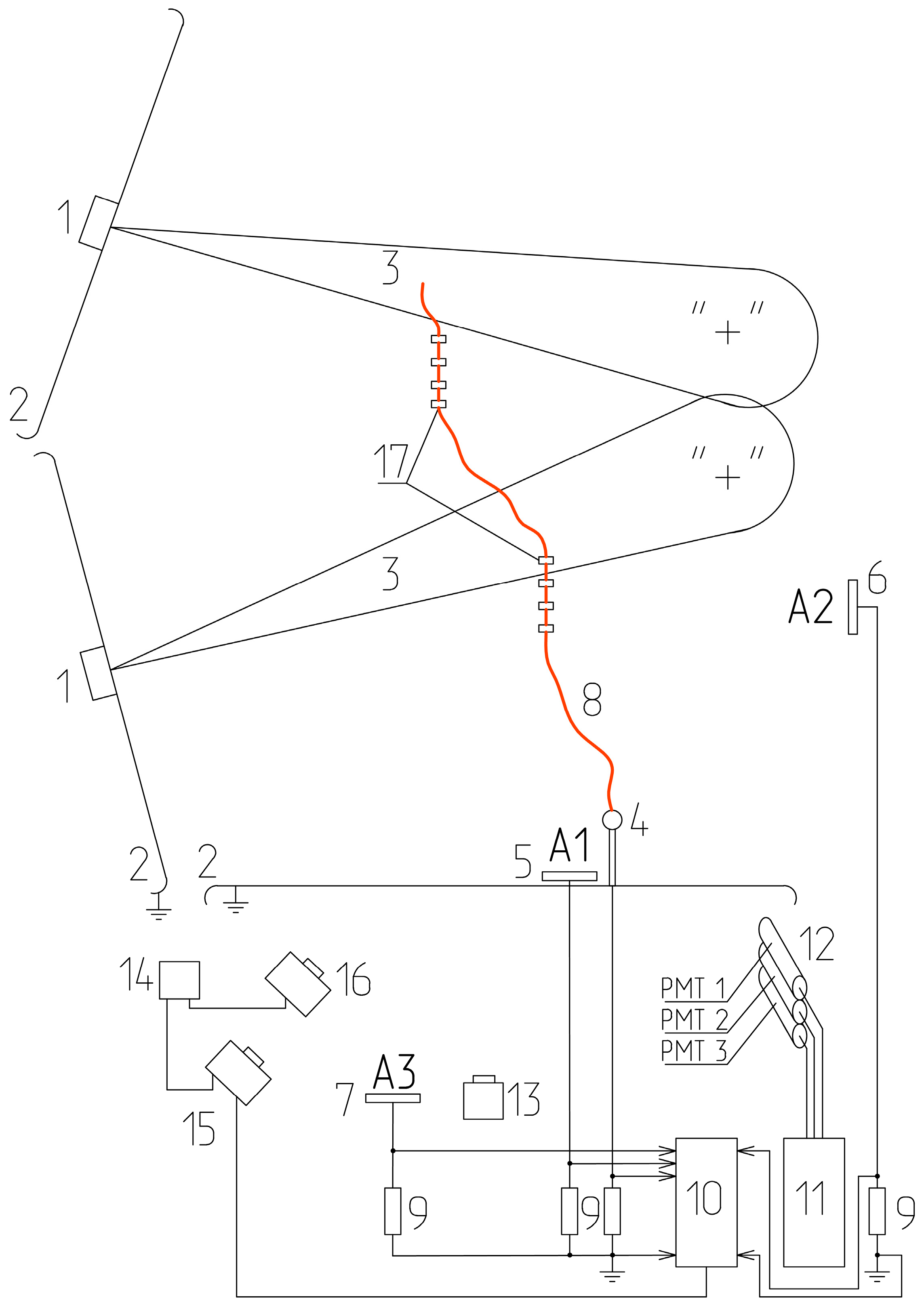
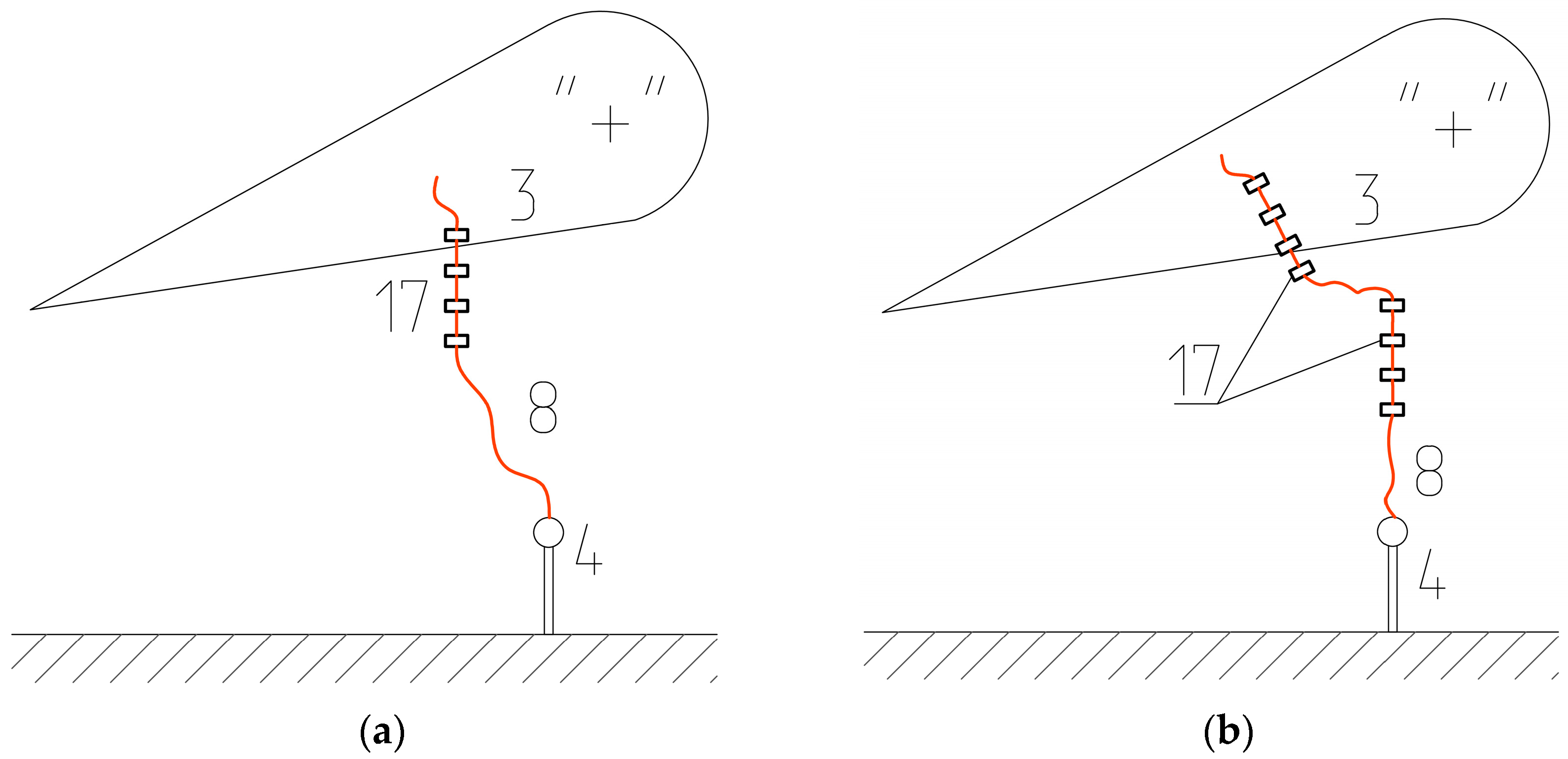

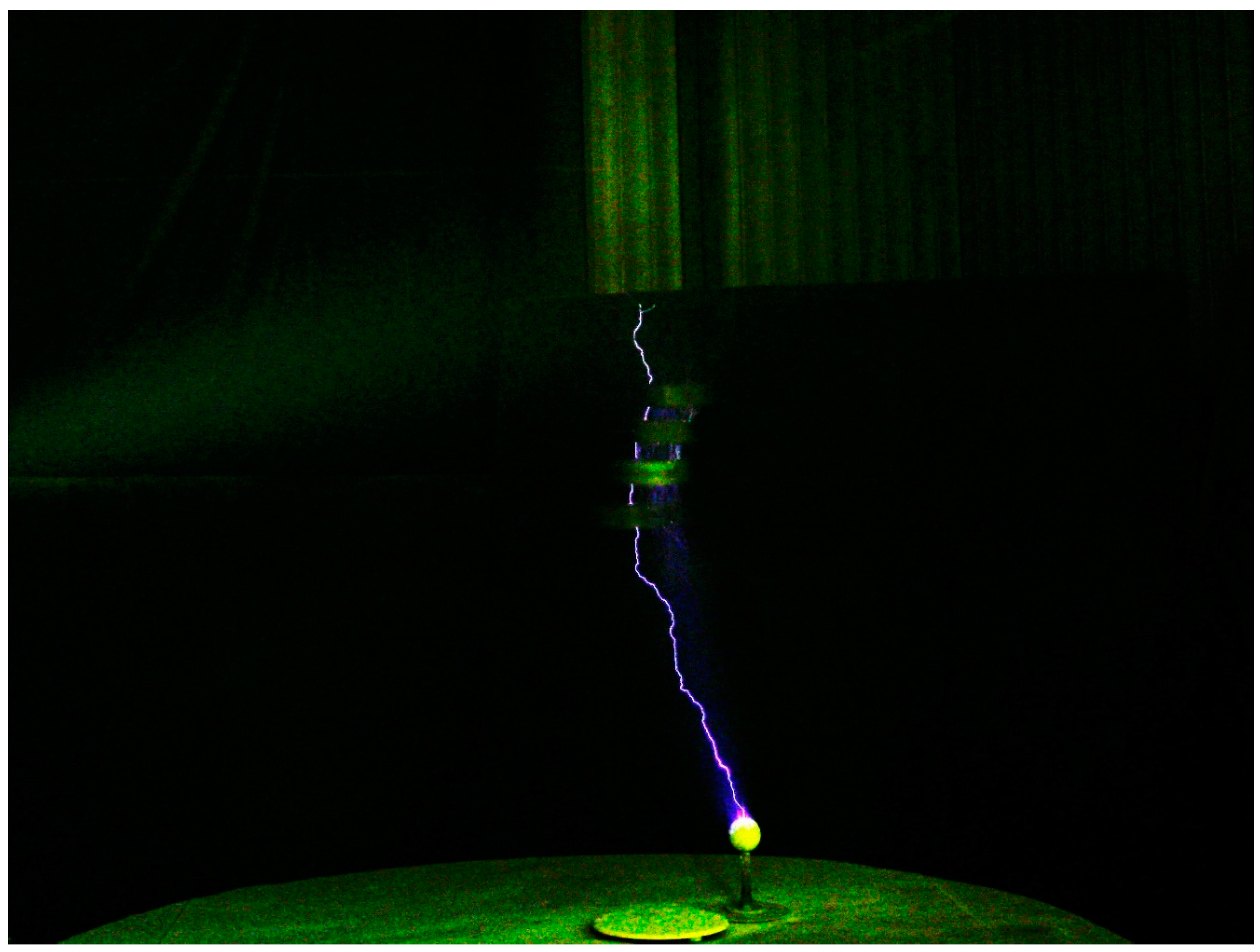
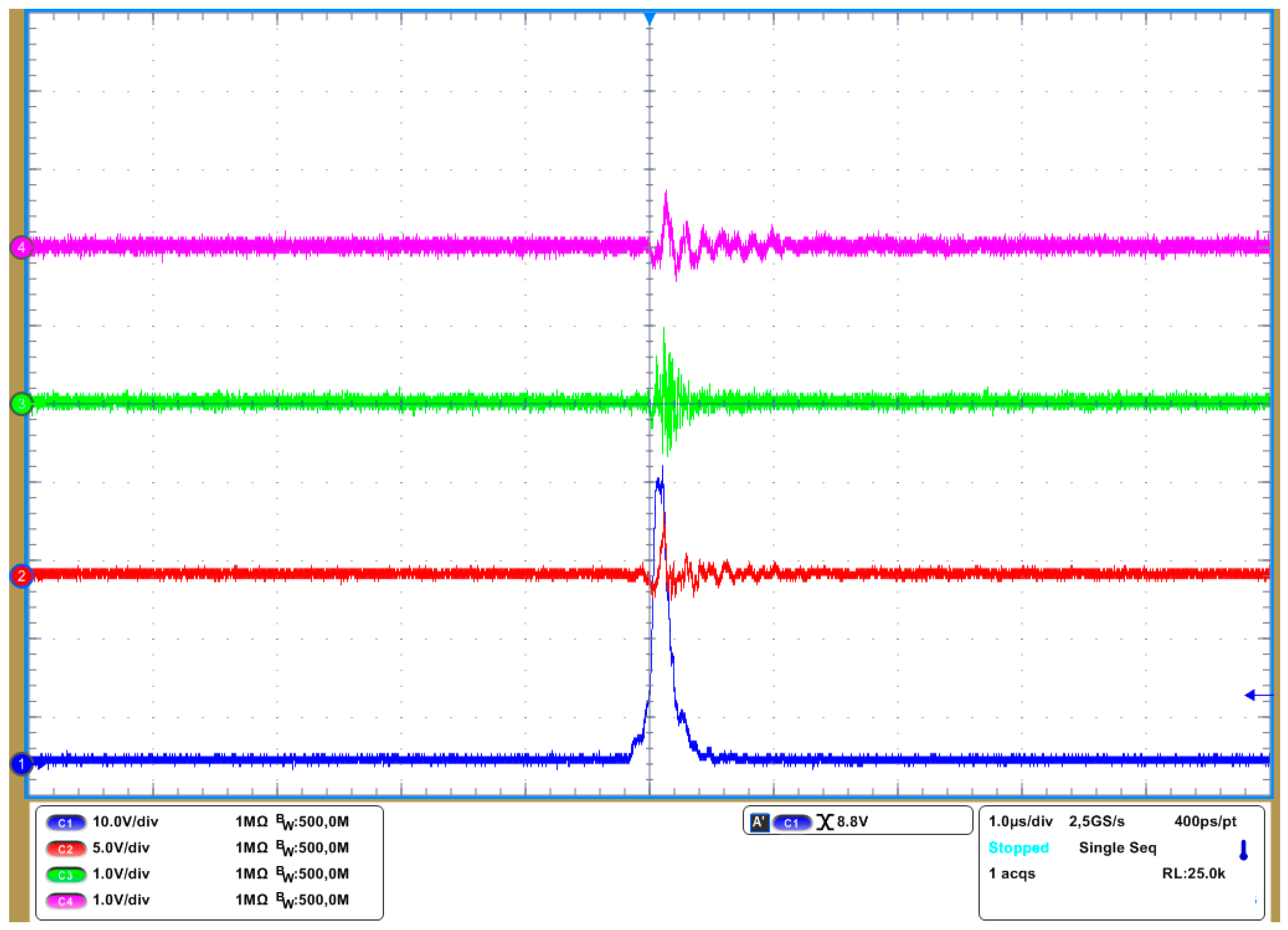
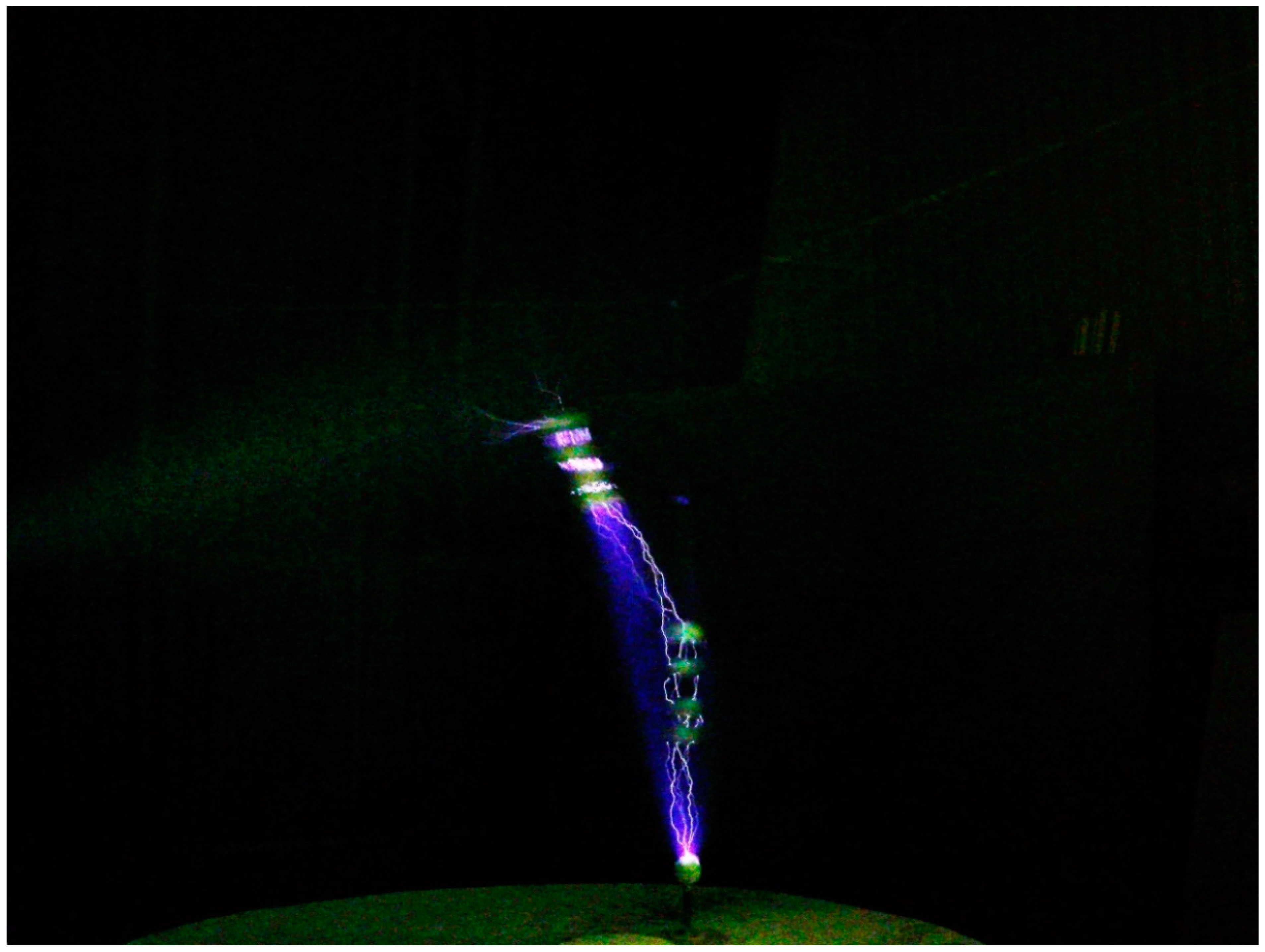

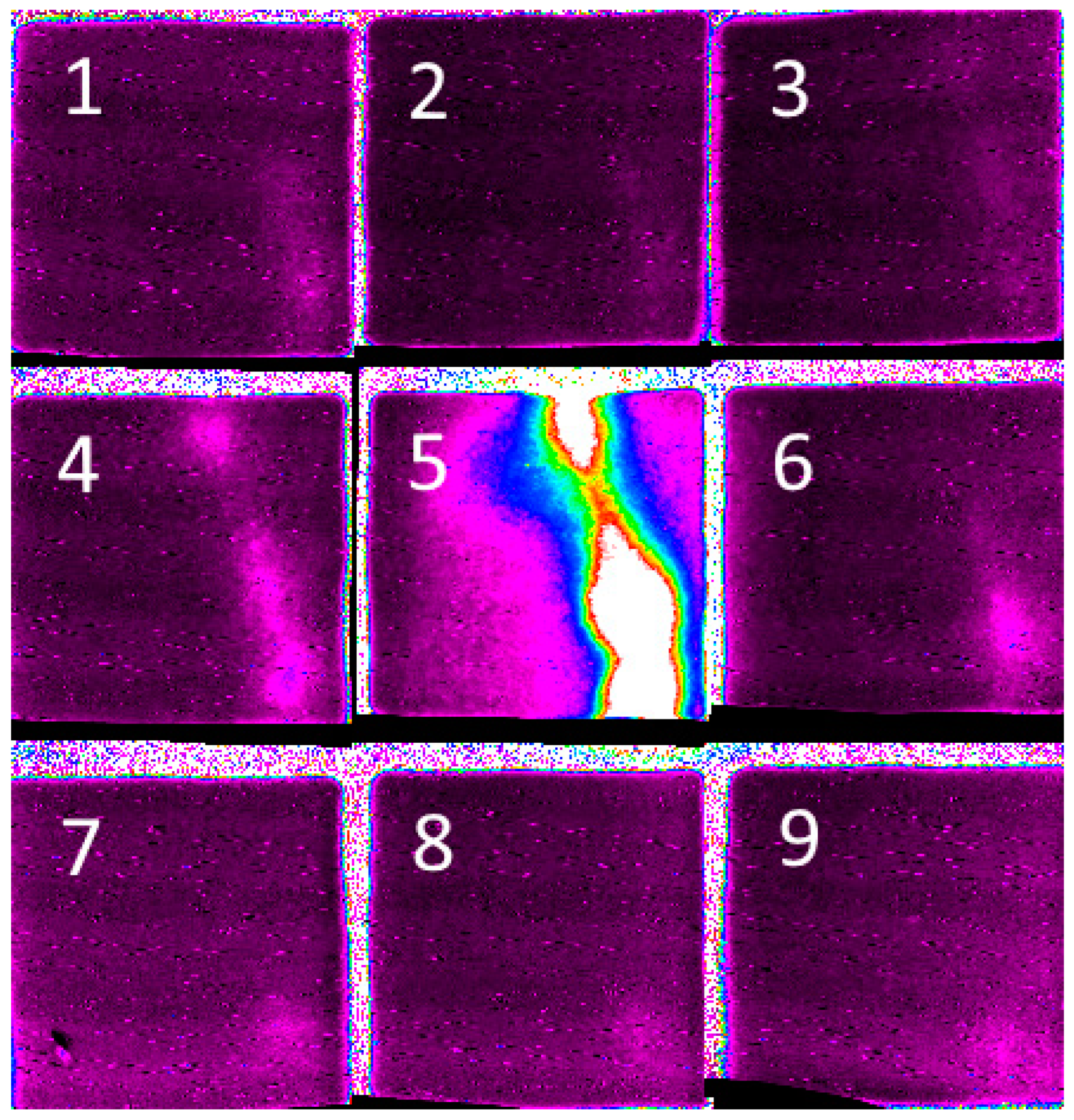

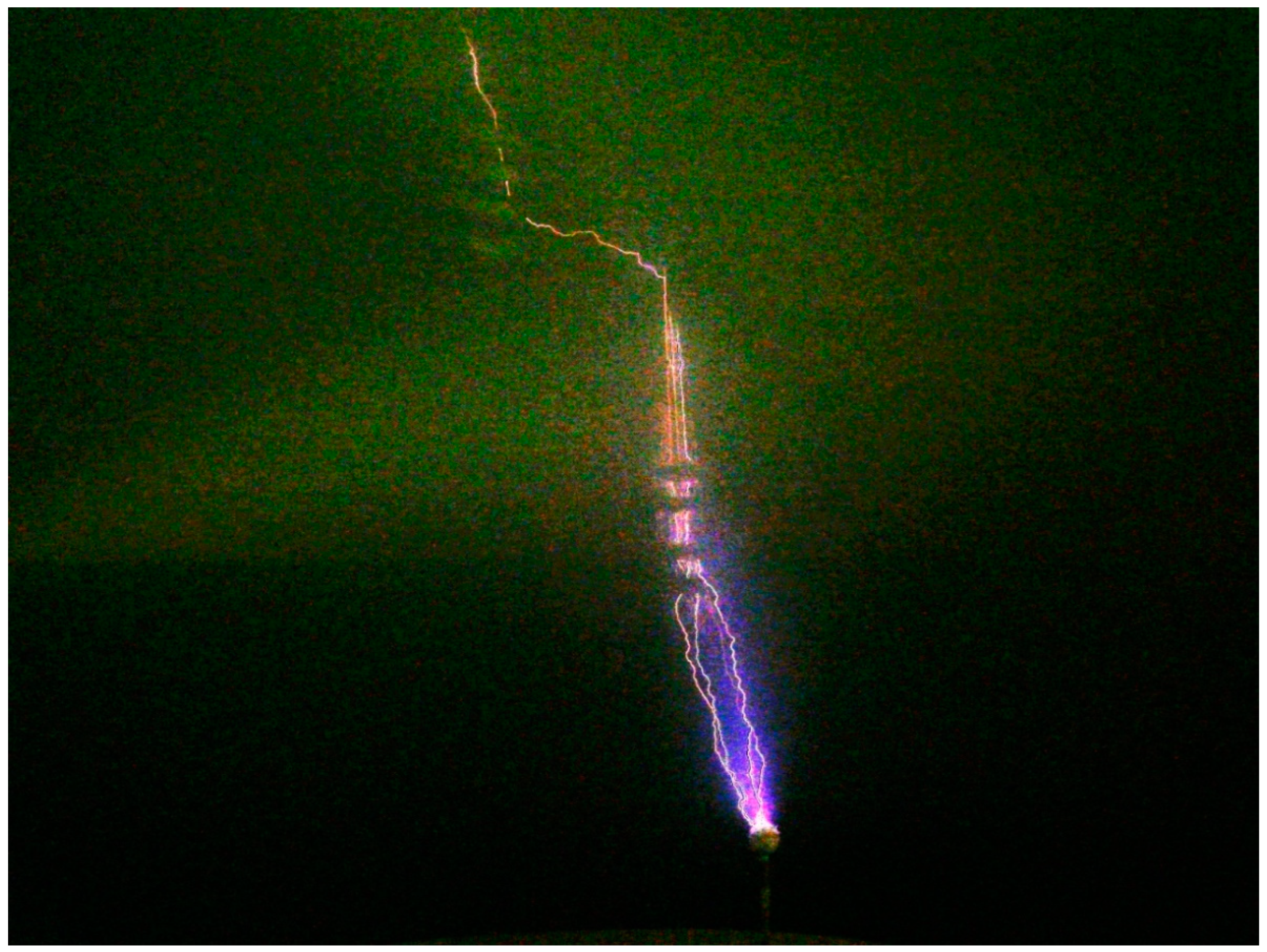
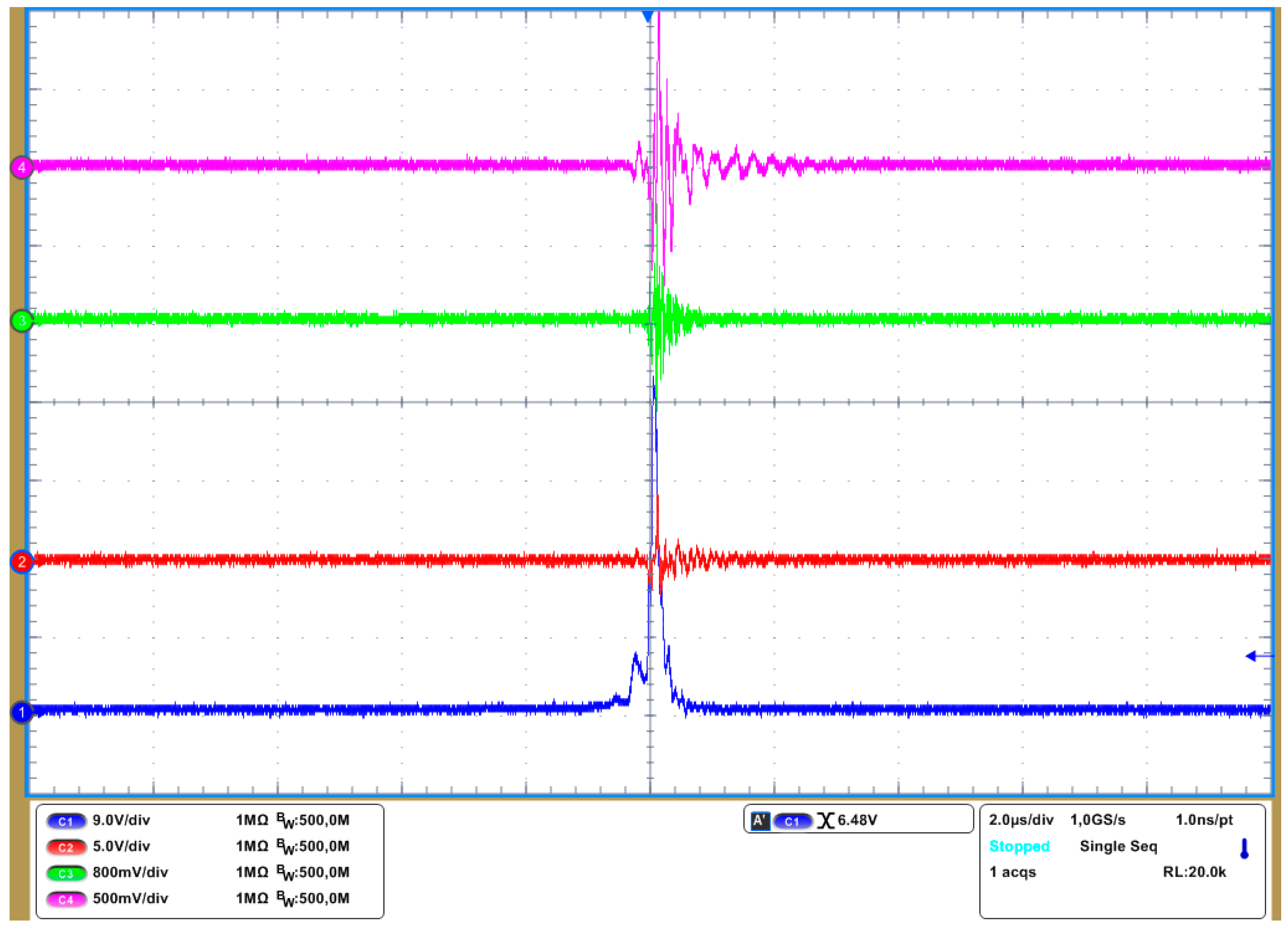
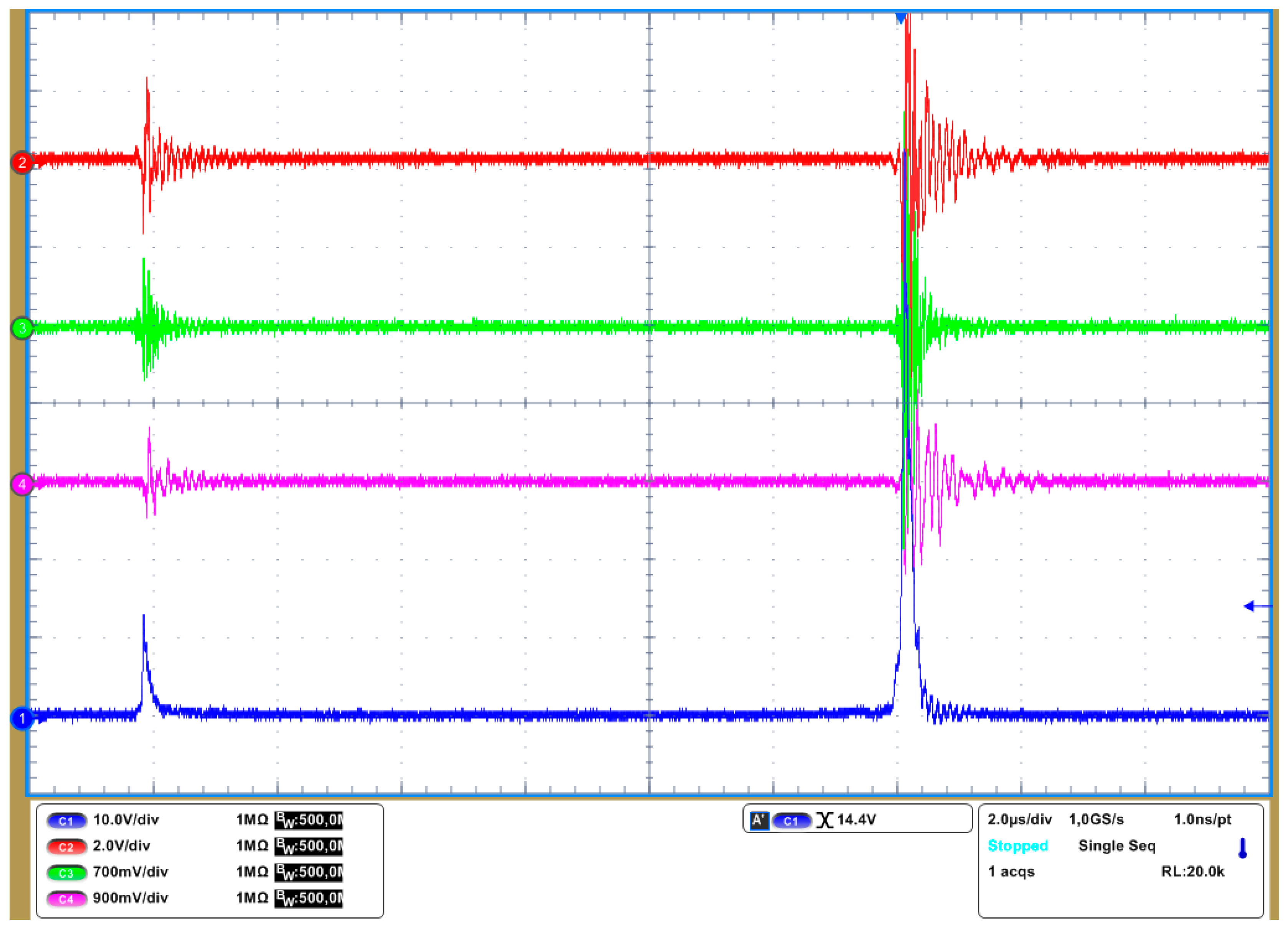

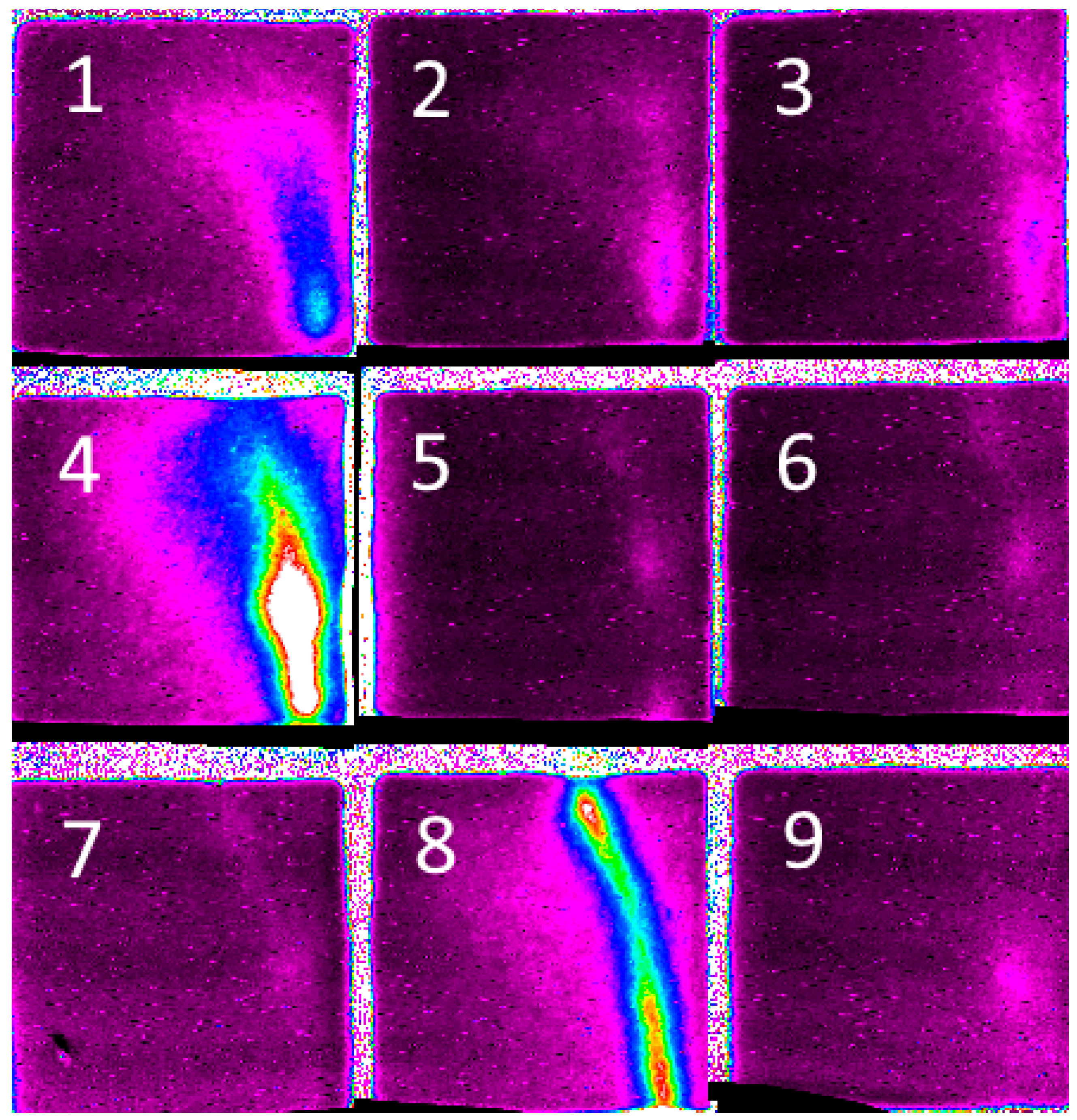
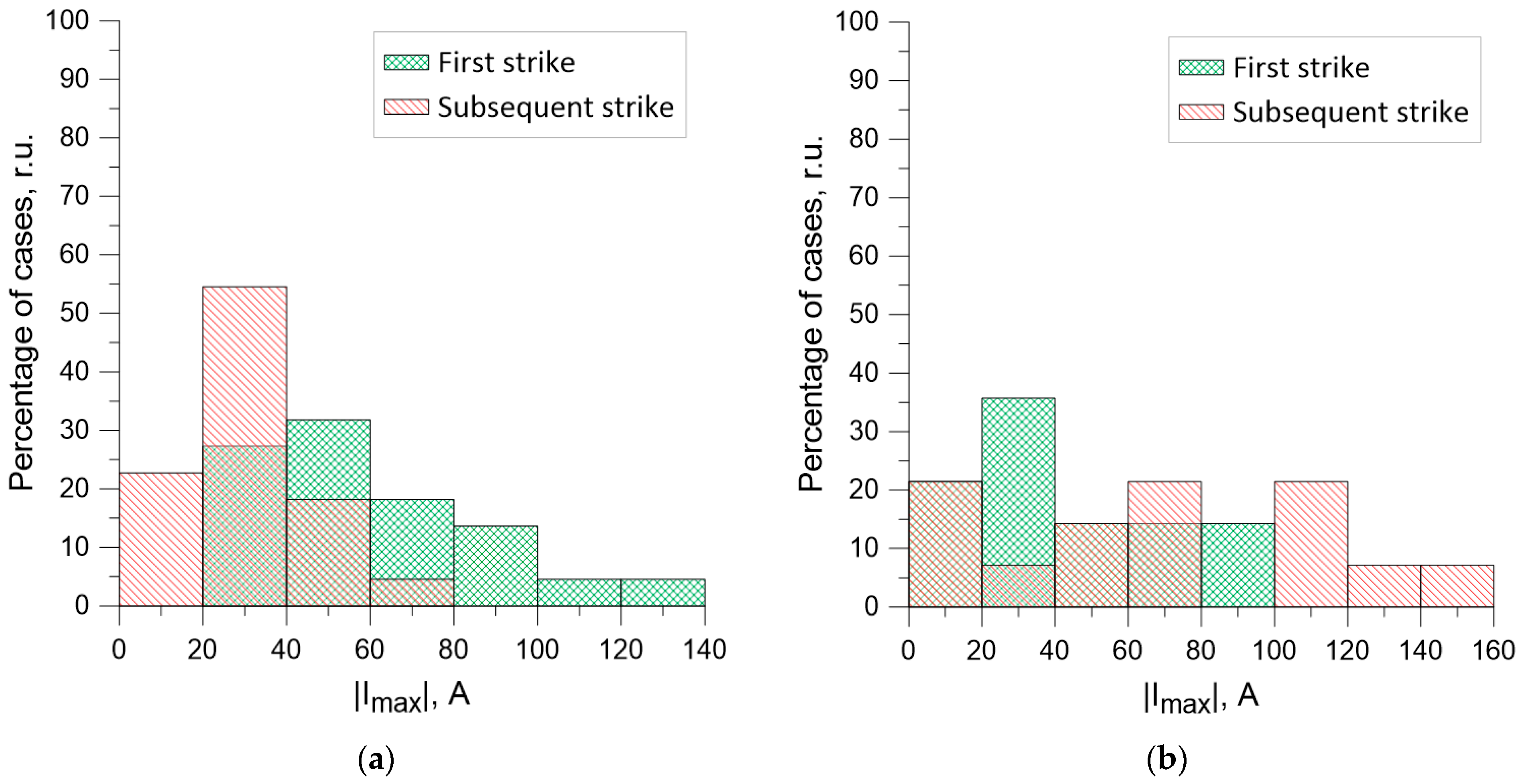
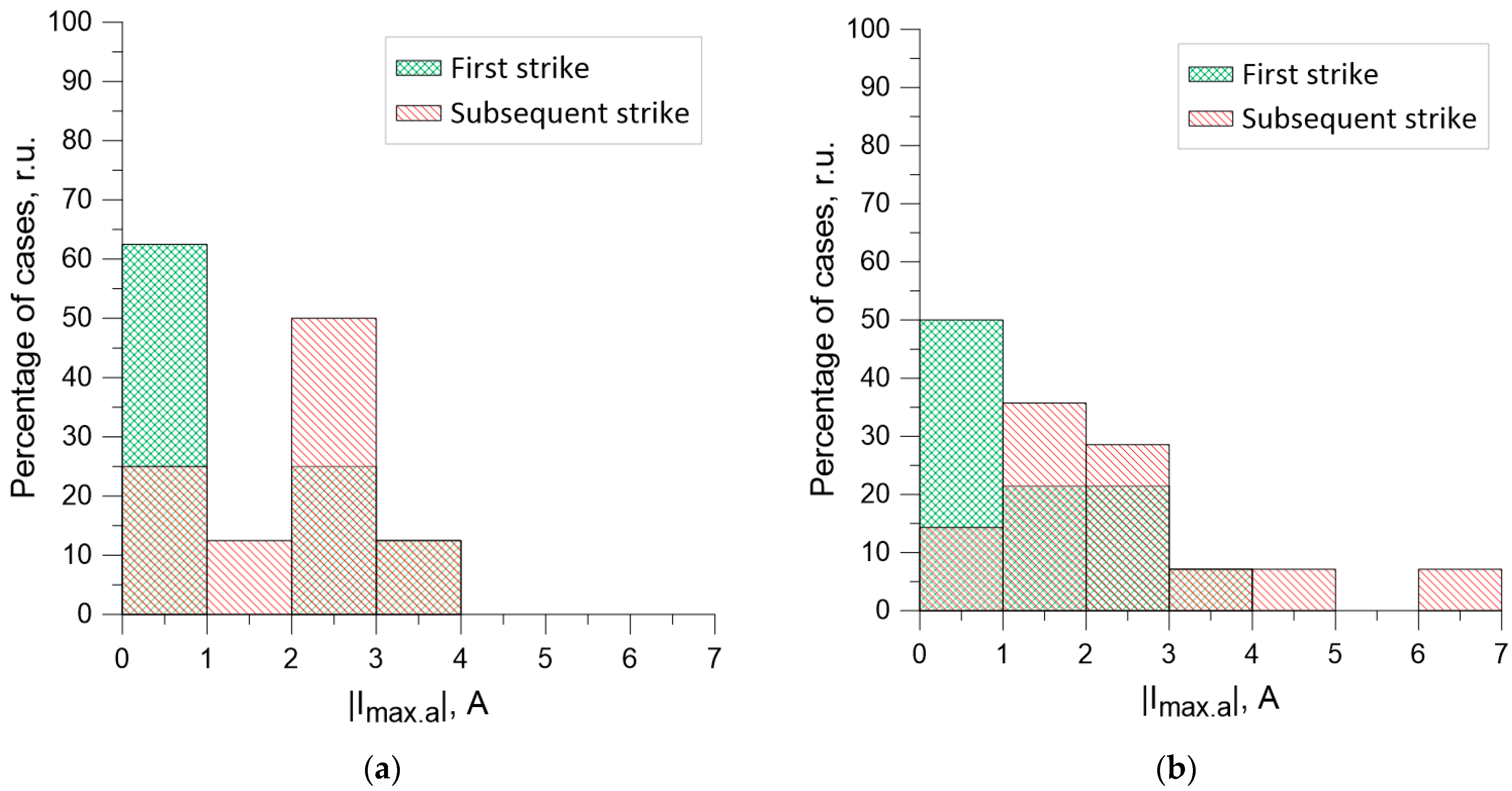
| Discharge Proportion, % | |Imax|, A | |Qsum|, µQ | |||
|---|---|---|---|---|---|
| First discharge | 7 | 22.7 [20.8 ÷ 25.6] | 2.89 [2.53 ÷ 3.4] | 0.33 [0.27 ÷ 0.39] | 0.53 [0.47 ÷ 0.61] |
| Repeated discharges | 53.6 [35.2 ÷ 78.4] | 8.77 [5.39 ÷ 11.12] | 0.94 [0.59 ÷ 1.58] | 1.08 [0.56 ÷ 1.9] | |
| Singular discharges | 93 | 101.2 [10.4 ÷ 193.6] | 13.97 [1.17 ÷ 24.51] | 1.59 [0.04 ÷ 14.0] | 2.14 [0.07 ÷ 13.0] |
| Discharge Proportion, % | |Imax|, A | |Qsum|, µQ | |||
|---|---|---|---|---|---|
| First discharge | 19 | 26.7 [12.9 ÷ 44.8] | 2.81 [1.11 ÷ 5.13] | 0.55 [0.09 ÷ 1.0] | 0.94 [0.11 ÷ 2.07] |
| Repeated discharges | 34.0 [12.0 ÷ 59.0] | 7.11 [1.99 ÷ 11.72] | 0.53 [0.04 ÷ 1.94] | 0.89 [0.13 ÷ 2.36] | |
| Singular discharges | 81 | 72.2 [12.3 ÷ 164.2] | 11.66 [0.64 ÷ 23.06] | 0.97 [0.13 ÷ 5.15] | 1.71 [0.13 ÷ 6.34] |
| Discharge Proportion, % | |Imax|, A | |Qsum|, µQ | |||
|---|---|---|---|---|---|
| First discharge | 27 | 25.5 [12.8 ÷ 61.6] | 2.64 [1.69 ÷ 3.63] | 1.05 [0.1 ÷ 4.78] | 5.24 [0.21 ÷ 30.8] |
| Repeated discharges | 57.9 [28.8 ÷ 110.4] | 12.68 [5.45 ÷ 18.63] | 0.84 [0.11 ÷ 1.44] | 1.27 [0.1 ÷ 2.61] | |
| Singular discharges | 73 | 86.1 [27.2 ÷ 182.4] | 13.33 [2.44 ÷ 24.80] | 1.76 [0.05 ÷ 13.2] | 3.61 [0.05 ÷ 32.0] |
| Discharge Proportion, % | |Imax|, A | |Qsum|, µQ | |||
|---|---|---|---|---|---|
| First discharge | 20 | 42.6 [15.2 ÷ 89.6] | 7.5 [2.17 ÷ 17.03] | 0.55 [0.11 ÷ 2.77] | 0.8 [0.12 ÷ 3.49] |
| Repeated discharges | 68.6 [10.1 ÷ 145.6] | 13.49 [2.19 ÷ 27.39] | 0.58 [0.03 ÷ 1.47] | 0.86 [0.05 ÷ 2.2] | |
| Singular discharges | 80 | 109 [30.4 ÷ 196] | 17.62 [2.36 ÷ 29.83] | 1.34 [0.16 ÷ 10] | 2.54 [0.2 ÷ 43.73] |
Disclaimer/Publisher’s Note: The statements, opinions and data contained in all publications are solely those of the individual author(s) and contributor(s) and not of MDPI and/or the editor(s). MDPI and/or the editor(s) disclaim responsibility for any injury to people or property resulting from any ideas, methods, instructions or products referred to in the content. |
© 2022 by the authors. Licensee MDPI, Basel, Switzerland. This article is an open access article distributed under the terms and conditions of the Creative Commons Attribution (CC BY) license (https://creativecommons.org/licenses/by/4.0/).
Share and Cite
Lysov, N.; Temnikov, A.; Chernensky, L.; Belova, O.; Orlov, A.; Kivshar, T.; Kovalev, D.; Zhuikov, A. Physical Modeling of Positive Multistrike Lightning Formation. Atmosphere 2023, 14, 10. https://doi.org/10.3390/atmos14010010
Lysov N, Temnikov A, Chernensky L, Belova O, Orlov A, Kivshar T, Kovalev D, Zhuikov A. Physical Modeling of Positive Multistrike Lightning Formation. Atmosphere. 2023; 14(1):10. https://doi.org/10.3390/atmos14010010
Chicago/Turabian StyleLysov, Nikolay, Alexander Temnikov, Leonid Chernensky, Olga Belova, Alexander Orlov, Tatiana Kivshar, Dmitry Kovalev, and Anton Zhuikov. 2023. "Physical Modeling of Positive Multistrike Lightning Formation" Atmosphere 14, no. 1: 10. https://doi.org/10.3390/atmos14010010





